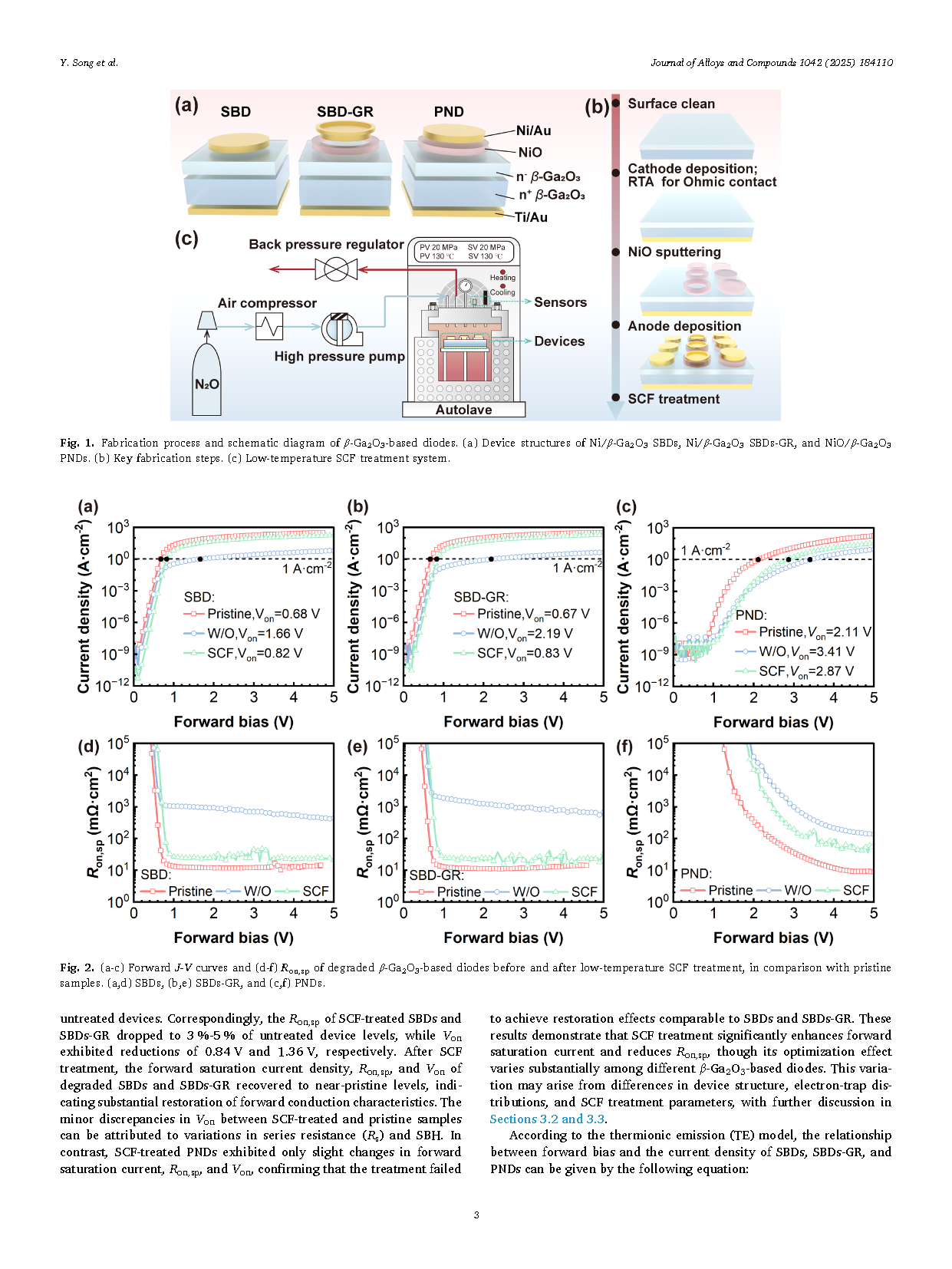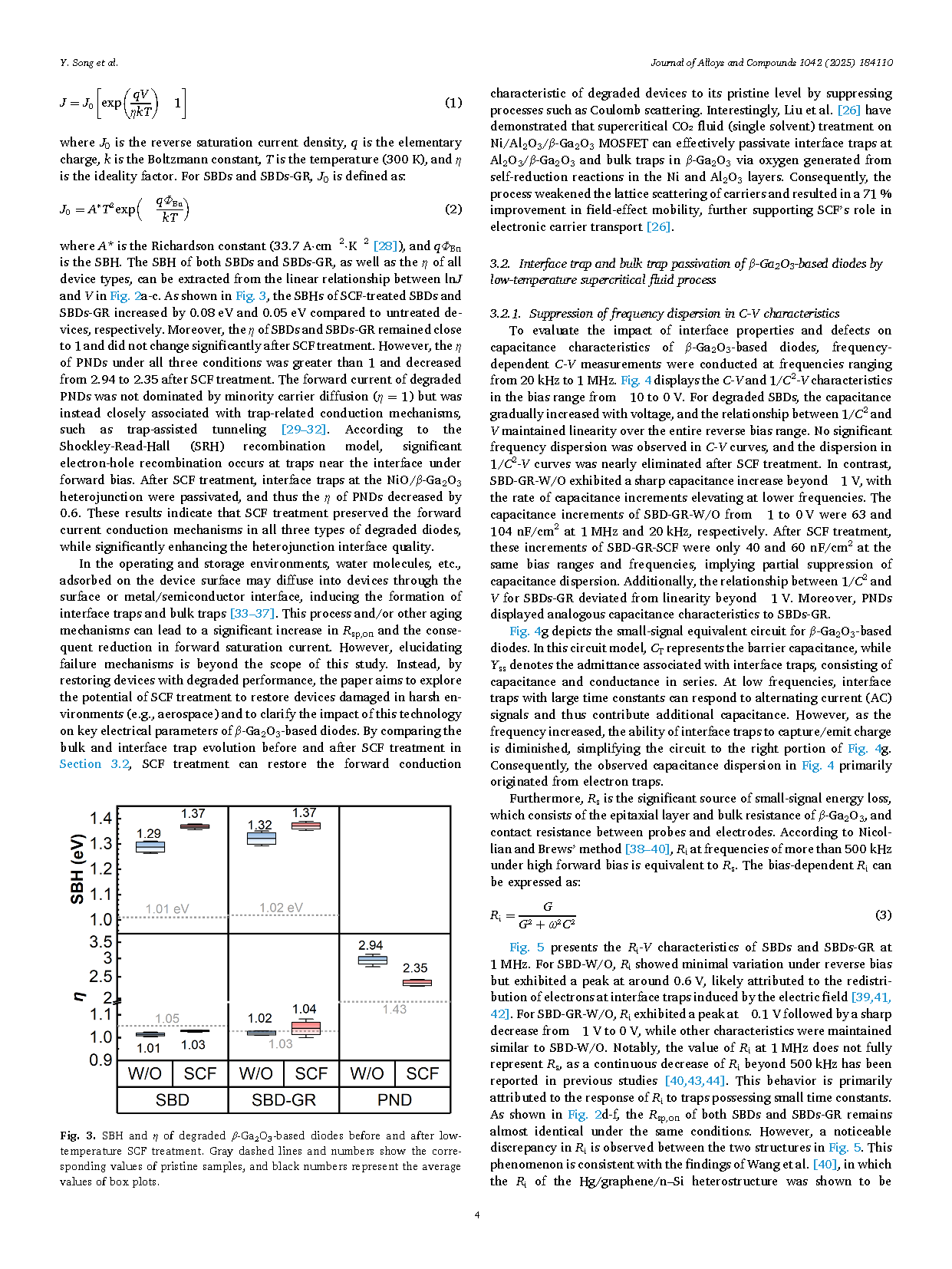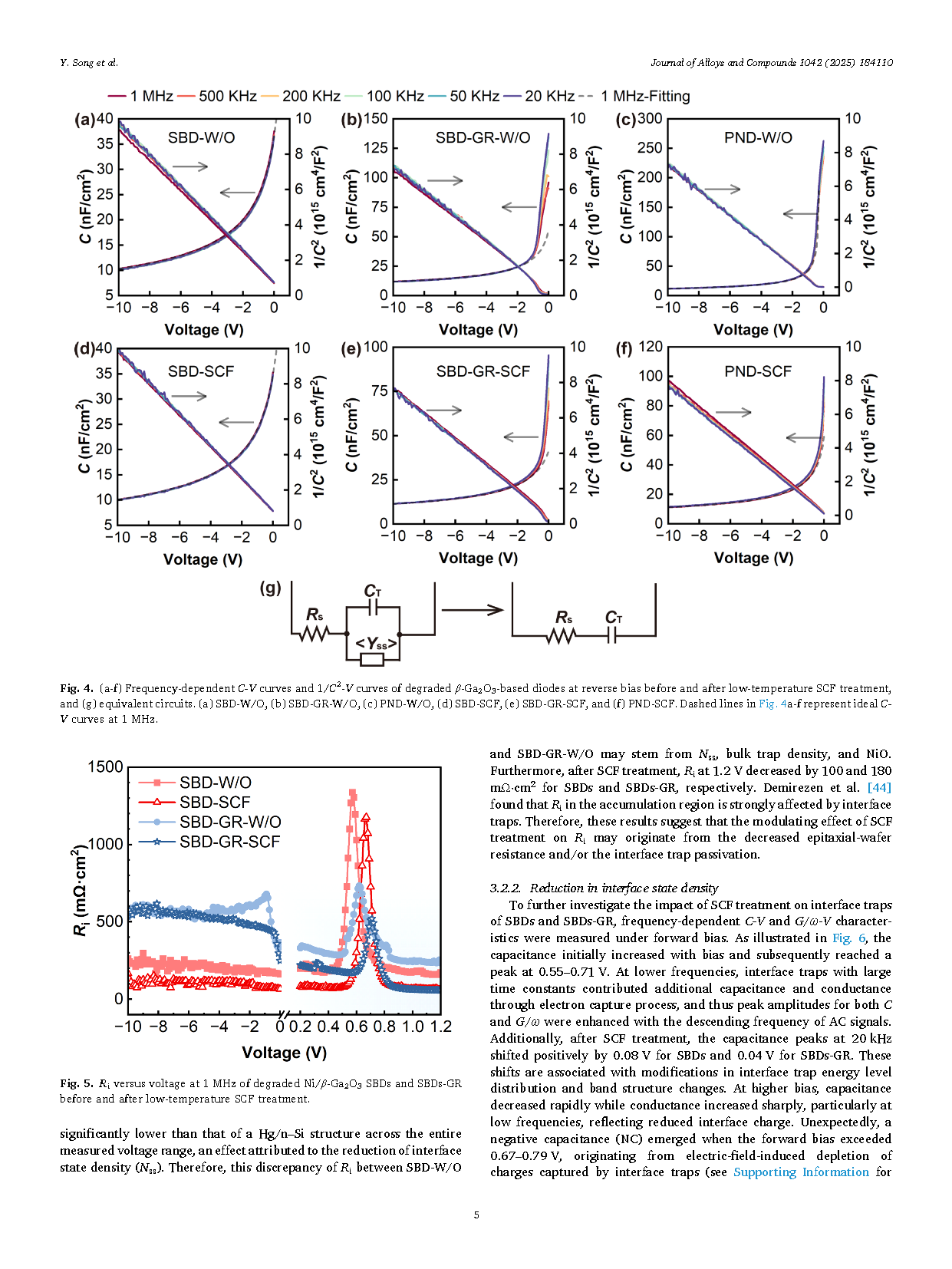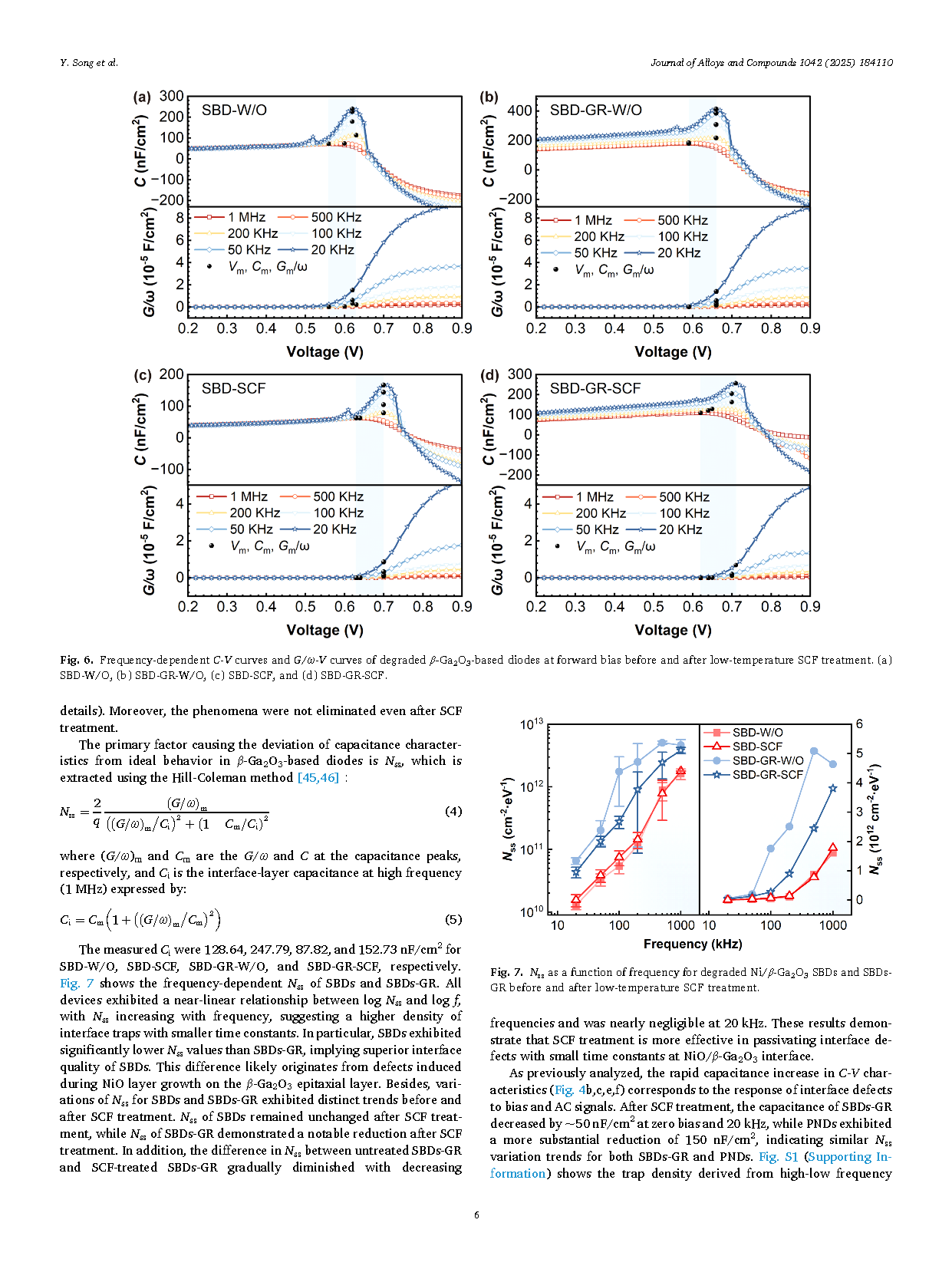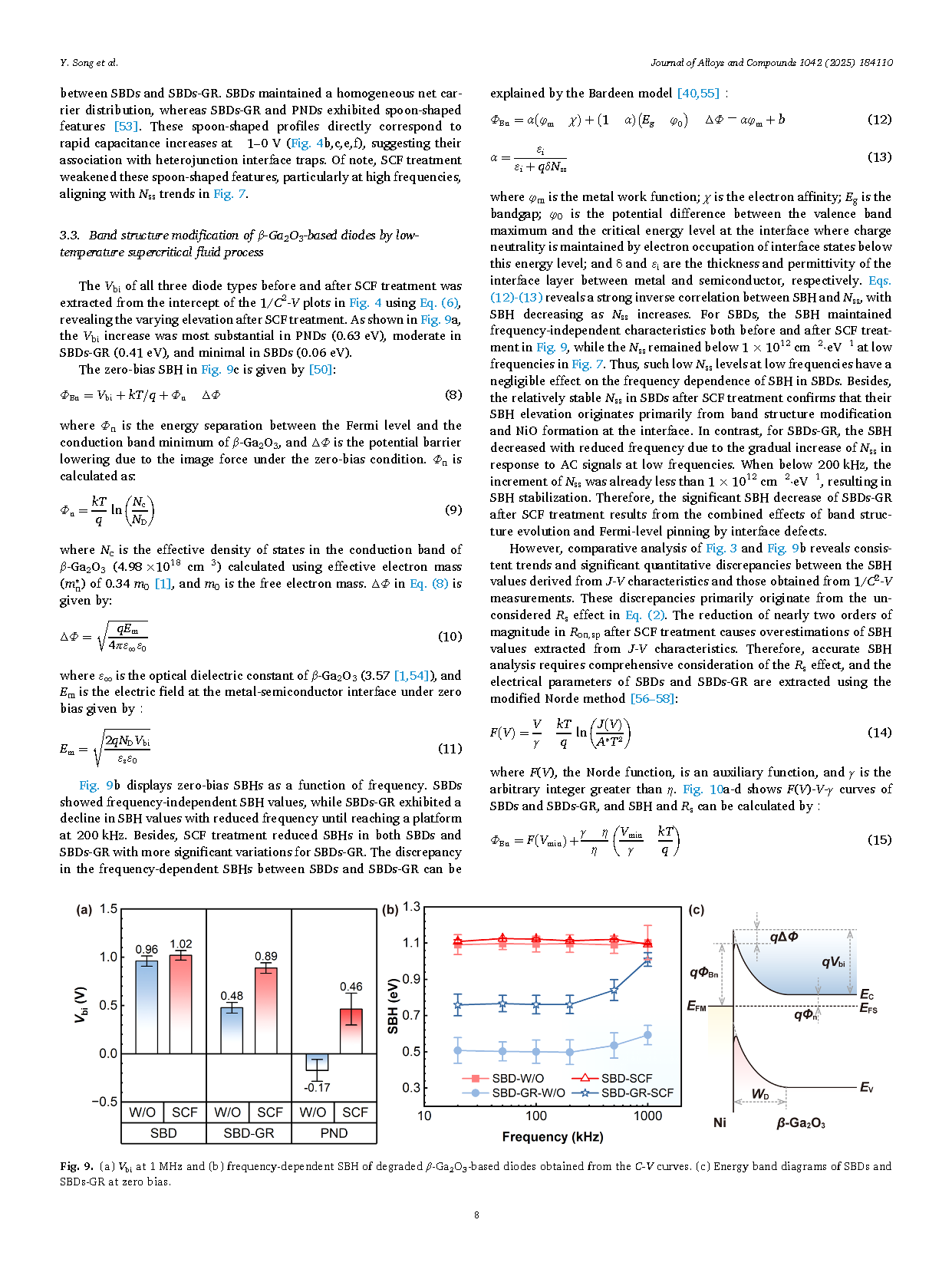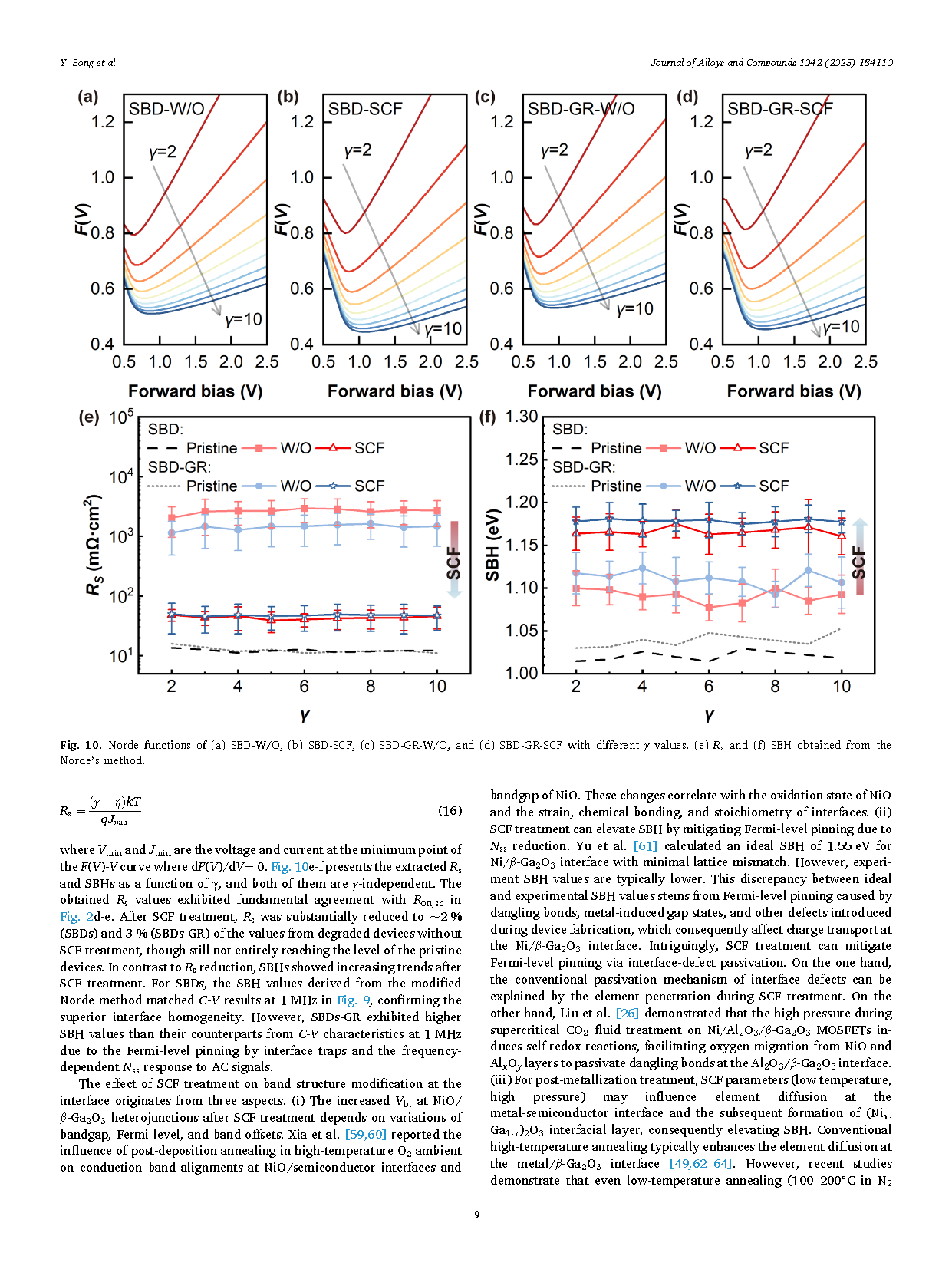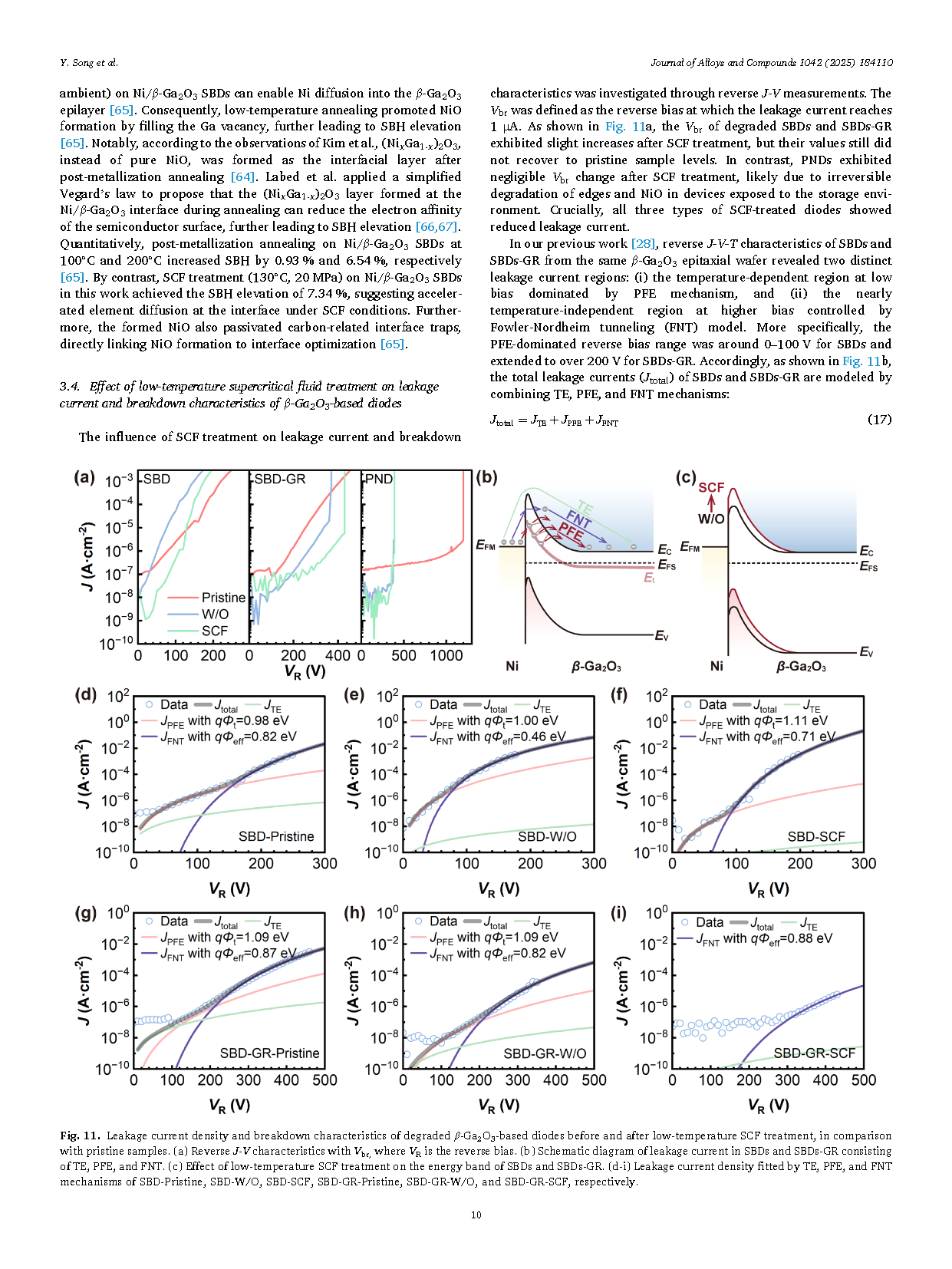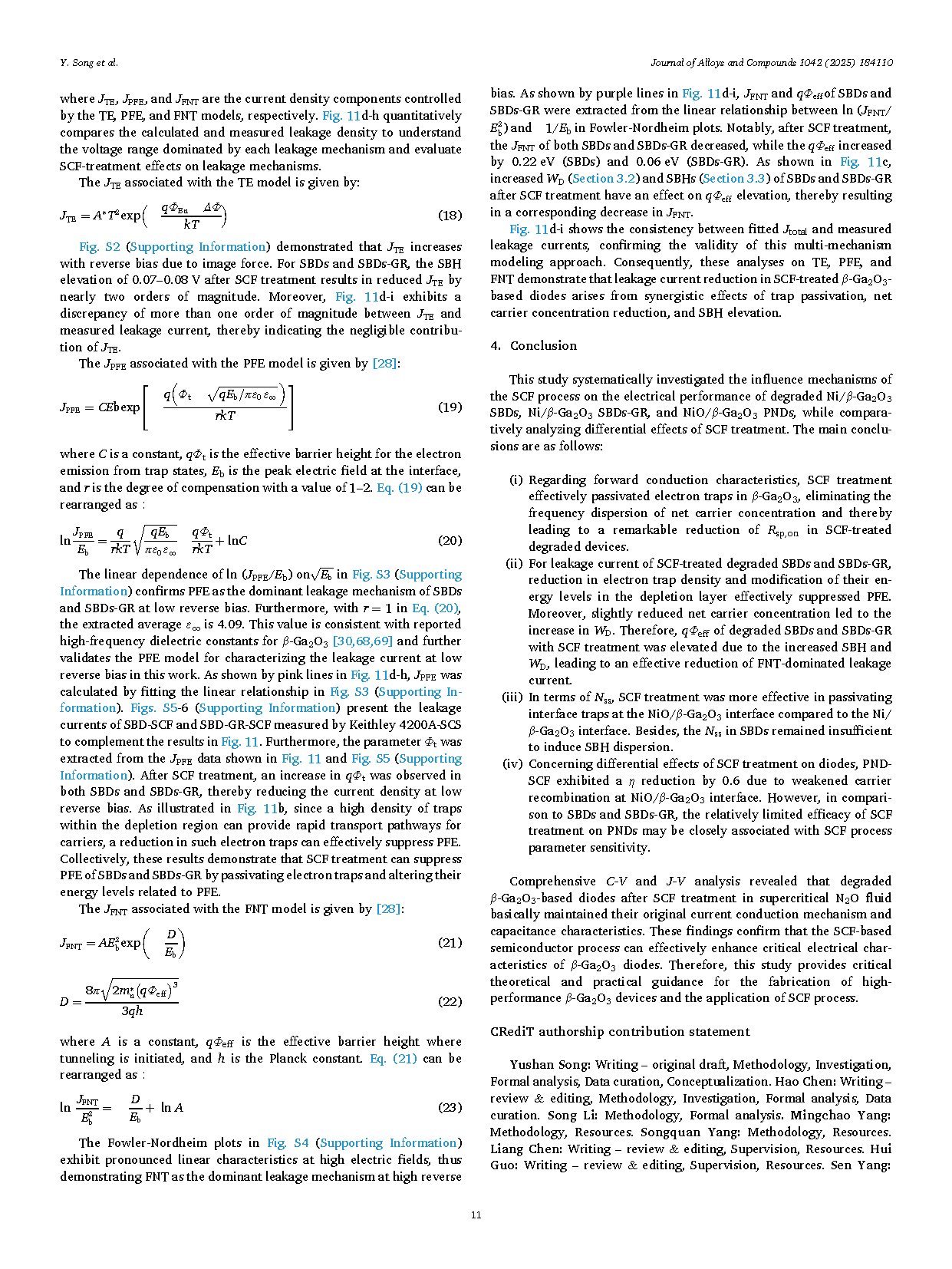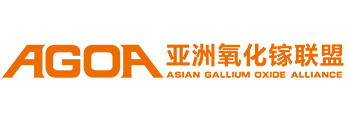

【Member Papers】Low-temperature supercritical fluid treatment for electrical performance restoration and enhancement in degraded β-Ga₂O₃-based diodes: synergistic effects of trap passivation, interface optimization, and band structure modification
日期:2025-10-29阅读:154
Researchers from the Xi’an Jiaotong University have published a dissertation titled "Low-temperature supercritical fluid treatment for electrical performance restoration and enhancement in degraded β-Ga2O3-based diodes: synergistic effects of trap passivation, interface optimization, and band structure modification" in Journal of Alloys and Compounds.
Project Support
The investigation was supported by the Steady Support Fund for National Key Laboratory under Award/Contract No. JBSY252800260, the Fundamental Research Funds of the State Key Laboratory of Wide-Bandgap Semiconductor Devices and Integrated Technology under Award/Contract No. 2413S121, and the National Natural Science Foundation of China under Award/Contract No. 62204198. Thanks Ms. Xuhui Wang in School of Microelectronics, Xi’an Jiaotong University, for her invaluable assistance in providing the measurement system.
Background
Gallium oxide (Ga2O3), as an ultrawide-bandgap semiconductor, exhibits remarkable application potential in power devices, nuclear radiation detectors and solar-blind deep-ultraviolet photodetectors due to its high theoretical breakdown field strength, high atomic displacement threshold energy, low-cost melt growth and excellent Baliga's figure of merit, and thus can be widely utilized in critical engineering fields and aerospace fields, such as wireless infrastructure, missile guidance systems and communication satellites. However, the performance and reliability of β-Ga2O3-based devices are constrained by two issues. On the one hand, the heterogeneous interface exhibits high-density interface traps, and surface damage induced by the etching process significantly increases surface roughness, near-surface trap density, and the inhomogeneity of Schottky barrier height (SBH). On the other hand, the degradation of electrical and material performance in operating environments, such as radiation-induced defect accumulation in extreme aerospace environments, further deteriorates the stability of devices. Although conventional high-temperature annealing and plasma treatments can partially mitigate these issues, they suffer from deficiencies such as the tendency to introduce secondary damages that hinder the device commercialization.
Abstract
The low-temperature supercritical fluid (SCF) process demonstrates significant potential in enhancing electrical performance and restoring degraded characteristics of (ultra-)wide bandgap semiconductor devices. This study investigated the effect of low-temperature supercritical N2O fluid treatment on ultrawide-bandgap β-Ga2O3-based diodes with degraded electrical properties exposed to the storage environment, including Ni/β-Ga2O3 Schottky barrier diodes (SBDs), Ni/β-Ga2O3 SBDs with NiO rings (SBDs-GR), and NiO/β-Ga2O3 PN junction diodes (PNDs). Electrical characterizations demonstrated that SCF treatment on degraded diodes significantly improved forward conduction characteristics and substantially reduced leakage current, primarily arising from the synergistic effects of trap passivation, interface optimization, and band structure modification. On the one hand, the restoration of forward saturation current density of degraded diodes after SCF treatment was accompanied by electron trap passivation. On the other hand, the reduction of leakage current after SCF treatment in SBDs and SBDs-GR was closely related to the suppression of Poole-Frenkel emission and Fowler-Nordheim tunneling. Besides, comparative analysis indicated that the SCF treatment exerted more pronounced effects on SBDs and SBDs-GR than on PNDs. This work substantiates the capability of SCF processing to restore degraded β-Ga2O3-based diodes while providing critical experimental evidence and theoretical support for its application in enhancing the electrical performance of β-Ga2O3-based devices.
Highlights
● Low-temperature supercritical fluid (SCF) treatment achieves improved forward conduction characteristics and reduced leakage current in degraded β-Ga2O3-based diodes.
● Variations in carrier conduction characteristics arise from the synergistic effects of trap passivation, interface optimization, and band structure modification.
● SCF treatment demonstrates device-dependent and structure-dependent effect.
Conclusion
This study systematically investigated the influence mechanisms of the SCF process on the electrical performance of degraded Ni/β-Ga2O3 SBDs, Ni/β-Ga2O3 SBDs-GR, and NiO/β-Ga2O3 PNDs, while comparatively analyzing differential effects of SCF treatment. The main conclusions are as follows:
● Regarding forward conduction characteristics, SCF treatment effectively passivated electron traps in β-Ga2O3, eliminating the frequency dispersion of net carrier concentration and thereby leading to a remarkable reduction of Rsp,on in SCF-treated degraded devices.
● For leakage current of SCF-treated degraded SBDs and SBDs-GR, reduction in electron trap density and modification of their energy levels in the depletion layer effectively suppressed PFE. Moreover, slightly reduced net carrier concentration led to the increase in WD. Therefore, qΦeff of degraded SBDs and SBDs-GR with SCF treatment was elevated due to the increased SBH and WD, leading to an effective reduction of FNT-dominated leakage current.
● In terms of Nss, SCF treatment was more effective in passivating interface traps at the NiO/β-Ga2O3 interface compared to the Ni/ β-Ga2O3 Besides, the Nss in SBDs remained insufficient to induce SBH dispersion.
● Concerning differential effects of SCF treatment on diodes, PND-SCF exhibited a η reduction by 0.6 due to weakened carrier recombination at NiO/β-Ga2O3 However, in comparison to SBDs and SBDs-GR, the relatively limited efficacy of SCF treatment on PNDs may be closely associated with SCF process parameter sensitivity.
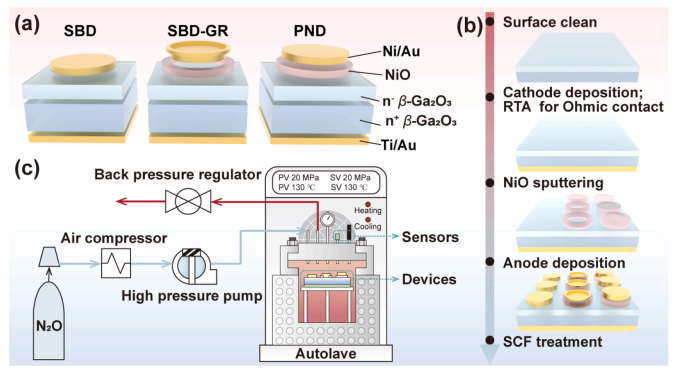
Fig. 1. Fabrication process and schematic diagram of β-Ga2O3-based diodes. (a) Device structures of Ni/β-Ga2O3 SBDs, Ni/β-Ga2O3 SBDs-GR, and NiO/β-Ga2O3 PNDs. (b) Key fabrication steps. (c) Low-temperature SCF treatment system.
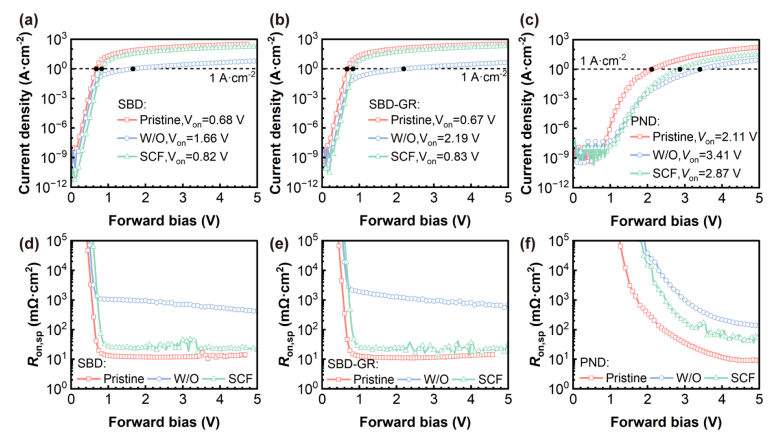
Fig. 2. (a-c) Forward J-V curves and (d-f) Ron,sp of degraded β-Ga2O3-based diodes before and after low-temperature SCF treatment, in comparison with pristine samples. (a,d) SBDs, (b,e) SBDs-GR, and (c,f) PNDs.
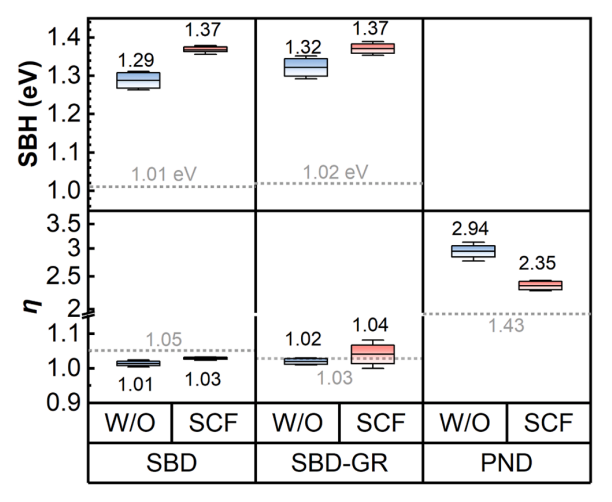
Fig. 3. SBH and η of degraded β-Ga2O3-based diodes before and after low-temperature SCF treatment. Gray dashed lines and numbers show the corresponding values of pristine samples, and black numbers represent the average values of box plots.
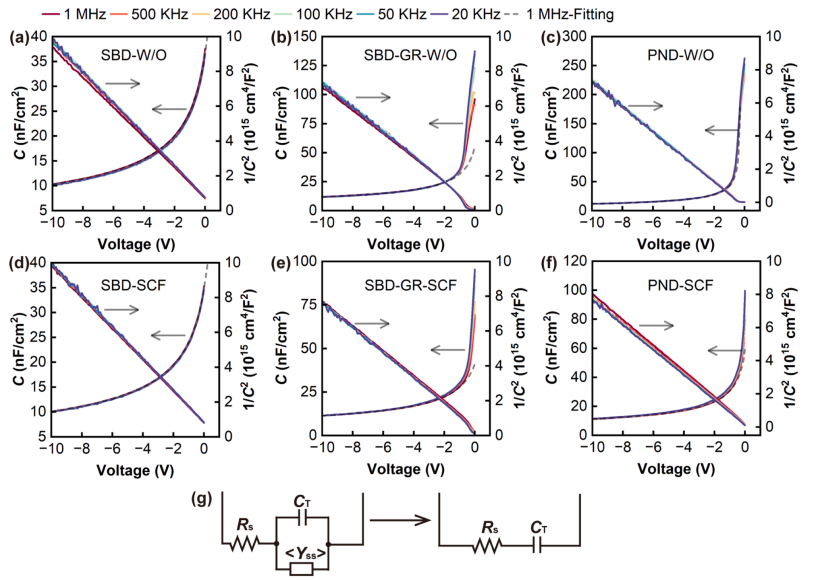
Fig. 4. (a-f) Frequency-dependent C-V curves and 1/C2 -V curves of degraded β-Ga2O3-based diodes at reverse bias before and after low-temperature SCF treatment, and (g) equivalent circuits. (a) SBD-W/O, (b) SBD-GR-W/O, (c) PND-W/O, (d) SBD-SCF, (e) SBD-GR-SCF, and (f) PND-SCF. Dashed lines in Fig. 4a-f represent ideal C-V curves at 1 MHz.
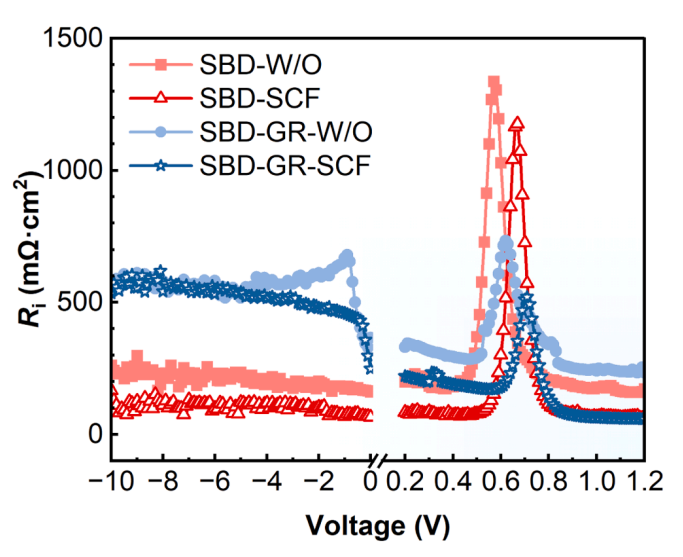
Fig. 5. Ri versus voltage at 1 MHz of degraded Ni/β-Ga2O3 SBDs and SBDs-GR before and after low-temperature SCF treatment.
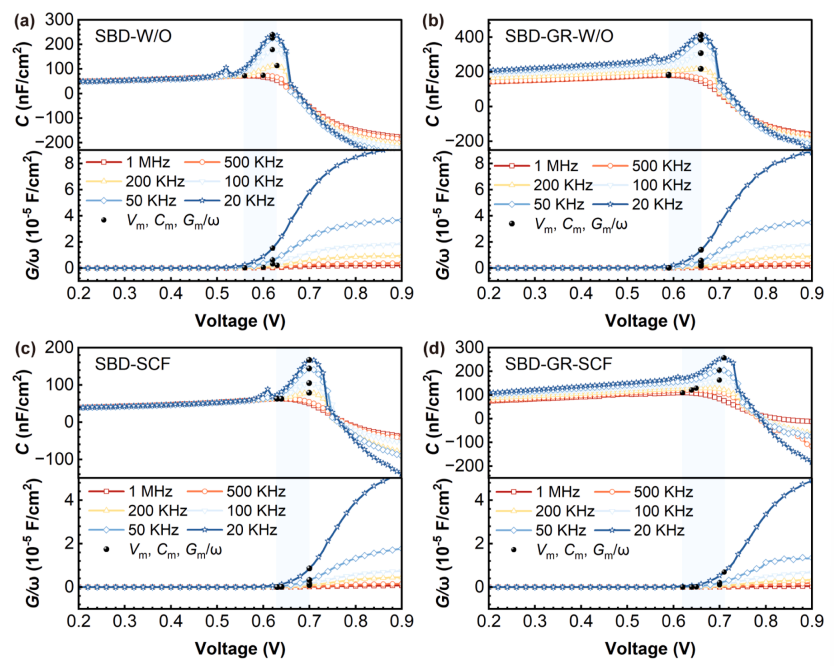
Fig. 6. Frequency-dependent C-V curves and G/ω-V curves of degraded β-Ga2O3-based diodes at forward bias before and after low-temperature SCF treatment. (a) SBD-W/O, (b) SBD-GR-W/O, (c) SBD-SCF, and (d) SBD-GR-SCF.
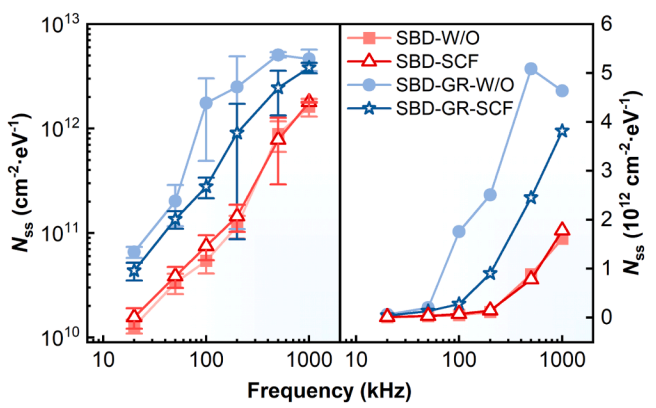
Fig. 7. Nss as a function of frequency for degraded Ni/β-Ga2O3 SBDs and SBDs-GR before and after low-temperature SCF treatment.
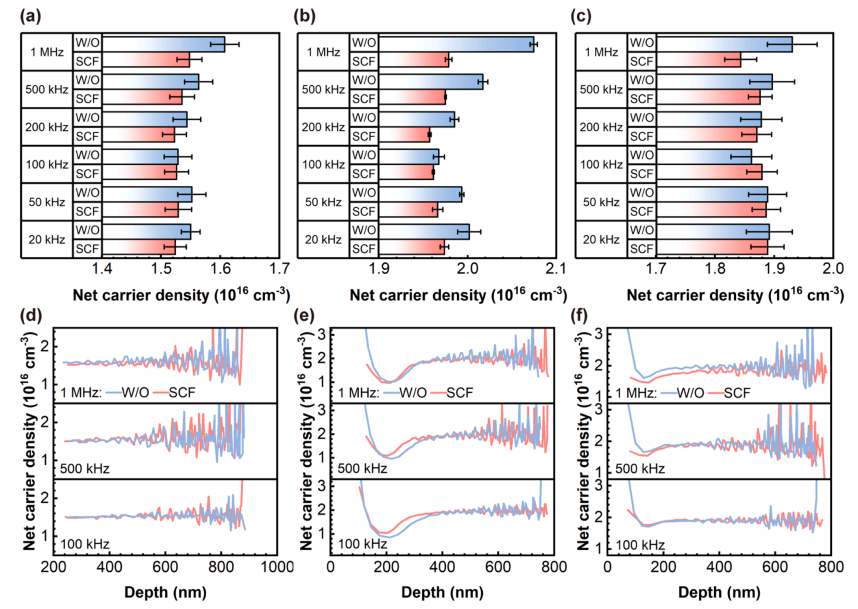
Fig. 8. (a-c) Net carrier concentration and (d-f) its distribution of degraded β-Ga2O3-based diodes at different frequencies derived from C-V curves. (a,d) SBDs, (b,e) SBDs-GR, and (c,f) PNDs.

Fig. 9. (a) Vbi at 1 MHz and (b) frequency-dependent SBH of degraded β-Ga2O3-based diodes obtained from the C-V curves. (c) Energy band diagrams of SBDs and SBDs-GR at zero bias.
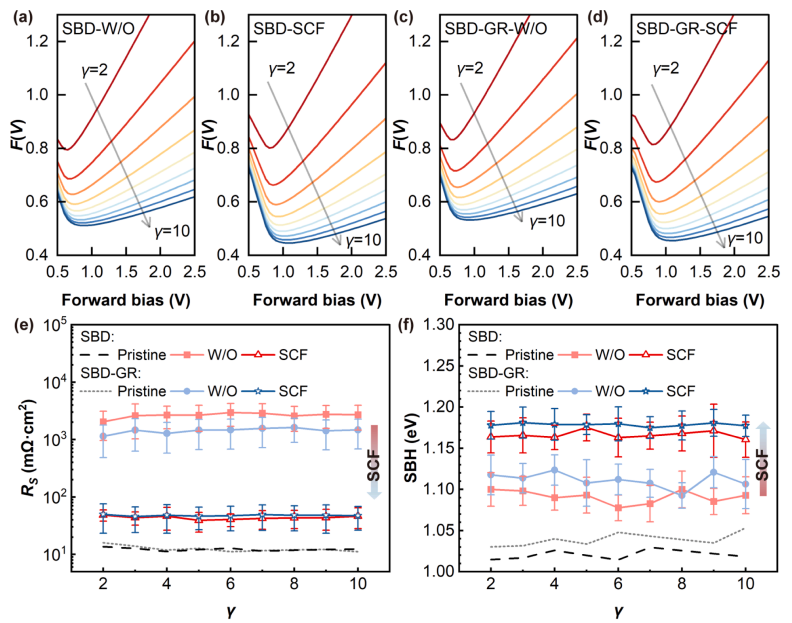
Fig. 10. Norde functions of (a) SBD-W/O, (b) SBD-SCF, (c) SBD-GR-W/O, and (d) SBD-GR-SCF with different γ values. (e) Rs and (f) SBH obtained from the Norde’s method.
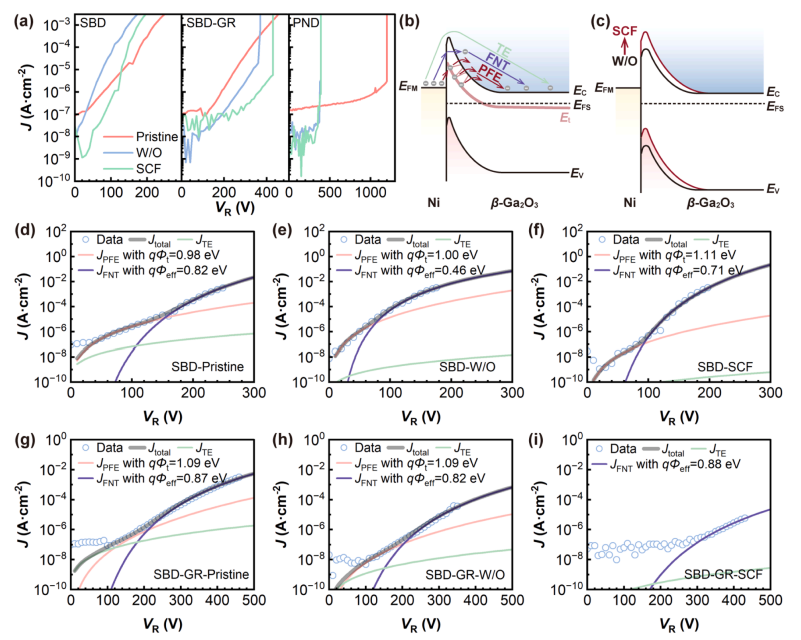
Fig. 11. Leakage current density and breakdown characteristics of degraded β-Ga2O3-based diodes before and after low-temperature SCF treatment, in comparison with pristine samples. (a) Reverse J-V characteristics with Vbr, where VR is the reverse bias. (b) Schematic diagram of leakage current in SBDs and SBDs-GR consisting of TE, PFE, and FNT. (c) Effect of low-temperature SCF treatment on the energy band of SBDs and SBDs-GR. (d-i) Leakage current density fitted by TE, PFE, and FNT mechanisms of SBD-Pristine, SBD-W/O, SBD-SCF, SBD-GR-Pristine, SBD-GR-W/O, and SBD-GR-SCF, respectively.
DOI:
doi.org/10.1016/j.jallcom.2025.184110

